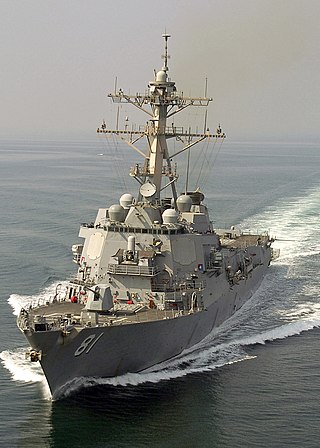
In naval terminology, a destroyer is a fast, maneuverable, long-endurance warship intended to escort larger vessels in a fleet, convoy, or battle group and defend them against powerful short-range attackers. They were originally developed in 1885 by Fernando Villaamil for the Spanish Navy as a defense against torpedo boats, and by the time of the Russo-Japanese War in 1904, these "torpedo boat destroyers" (TBDs) were "large, swift, and powerfully armed torpedo boats designed to destroy other torpedo boats". Although the term "destroyer" had been used interchangeably with "TBD" and "torpedo boat destroyer" by navies since 1892, the term "torpedo boat destroyer" had been generally shortened to simply "destroyer" by nearly all navies by the First World War.
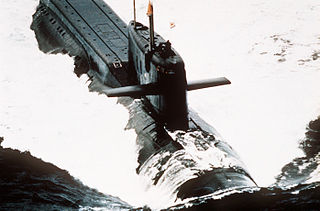
The Yankee class, Soviet designations Project 667A Navaga (navaga) and Project 667AU Nalim (burbot), was a series of nuclear-powered ballistic missile submarines built in the Soviet Union for the Soviet Navy. In total, 34 units were built: 24 in Severodvinsk for the Northern Fleet and the remaining 10 in Komsomolsk-on-Amur for the Pacific Fleet. Two Northern Fleet units were later transferred to the Pacific. The lead boat K-137 Leninets received its honorific name on 11 April 1970, two and one half years after being commissioned.

The Bulgarian Navy is the navy of the Republic of Bulgaria and forms part of the Bulgarian Armed Forces. It has been largely overlooked in the reforms that Bulgaria had to go through in order to comply with NATO standards, mostly because of the great expense involved and the fact that naval assaults are not considered to be a great concern for the country's security. That is why three of the four Romeo-class submarines are now docked and have been out of operation for some time. The last one was decommissioned in November 2011. Only the more modern frigates, corvettes and missile crafts are on active duty.

The Yugoslav Navy, was the navy of Yugoslavia from 1945 to 1992. It was essentially a coastal defense force with the mission of preventing enemy landings along Yugoslavia's rugged 4,000-kilometer shoreline or coastal islands, and contesting an enemy blockade or control of the strategic Strait of Otranto.

The Koni class is the NATO reporting name for an anti-submarine warfare frigate built by the Soviet Union. They were known in the Soviet Union as Project 1159. 14 were built in Zelenodolsk shipyard between 1975 and 1988. They were originally intended to replace the older Riga-class frigates, but were instead chosen as a design for export to various friendly navies. The Koni I sub class were designed for European waters and the Koni II were made for warmer waters. One ship was retained by the Soviets in the Black Sea for training foreign crews. Only a few of these vessels remain in service today.

The Project 670 Skat submarine was a nuclear-powered cruise missile submarine built for the Soviet Navy and later operated by the Russian Navy. All Charlie I/II-class submarines are decommissioned. One Charlie-class submarine was used for testing an Oniks missile. Charlie I and its successor Charlie II-class submarines are designed by the Lazurit Central Design Bureau of Gorky.

The Kola class was the NATO reporting name for a group of frigates built for the Soviet Navy in the 1950s. The Soviet designation was Storozhevoi Korabl Project 42. These ships were analogous to World War II era destroyer escorts or German Elbing-class torpedo boats. The programme consisted of only 8 ships as these vessels were considered to be too expensive for series production and the smaller and cheaper Riga-class frigate was built instead. Radars and sonars were fitted.

The Project 205 Moskit (mosquito) more commonly known by their NATO reporting name Osa, are a class of missile boats developed for the Soviet Navy in the late 1950s. Until 1962 this was classified as a large torpedo boat.
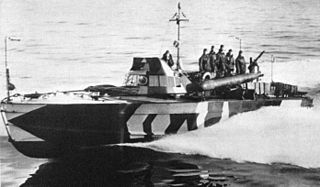
Motoscafo armato silurante, commonly abbreviated as MAS, was a class of fast torpedo-armed vessels used by the Regia Marina during World War I and World War II. Originally, "MAS" referred to motobarca armata SVAN, Società Veneziana Automobili Navali.
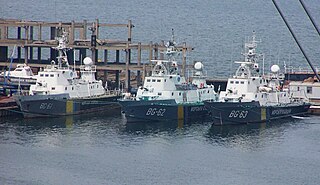
The Stenka class is the NATO reporting name for a class of patrol boats built for the Soviet Navy and Soviet Allies. The Soviet designation was Project 205P Tarantul. The boats are an anti-submarine (ASW) patrol boat version of the Osa-class missile boat.

"Turya class" is the NATO reporting name for a class of hydrofoil torpedo boats built for the Soviet Navy and Soviet allies. The Soviet designation was Project 206M.

The Matka class is the NATO reporting name for a group of hydrofoil missile boats built for the Soviet Navy. The Soviet designation was Project 206MR Vikhr. Following the 1997 Black Sea Fleet partition treaty all Black Sea Fleet Matka class boats were passed to the Ukrainian Navy

The Končar class is a class of six missile boats built for the Yugoslav Navy during the late 1970s at Tito's Shipyard Kraljevica, SR Croatia. The boats featured a mixture of Western and Eastern European equipment, including Soviet anti-ship missiles and Swedish guns.
The Mornar class consisted of two large patrol boats built for the Yugoslav Navy by the Tito's Shipyard in Kraljevica during the late 1950s and early 1960s. The boats were based on the Udarnik (PBR-581), a French-built Le Fougueux-class submarine chaser acquired in 1956. Both boats had an uneventful career and were deleted in 1992.

Šibenik is a Končar-class missile boat in service with the Croatian Navy. It was built for the Yugoslav Navy at the Kraljevica Shipyard in the 1970s as Vlado Ćetković (RTOP-402). In 1991 during the early stages of the Croatian War of Independence it was captured by Croatian forces while being overhauled at the "Velimir Škorpik" shipyard in Šibenik.

Šolta is a Mirna-class patrol boat in service with the Croatian Navy. Completed during the 1980s as Mukos (PČ-176), it was the sixth ship of a class that was being built for the Yugoslav Navy in the Kraljevica Shipyard.
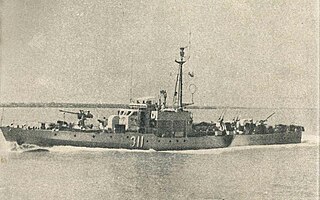
The Kraljevica class was a class of large anti-submarine patrol boats built for the Yugoslav Navy during the 1950s. Built by the Tito's Shipyard in Kraljevica, the 24 boats of the class were built in two series, the first from 1951 until 1954 and the second from 1954 until 1957. Although similar in layout, boats of the second series featured a slightly larger displacement and more powerful machinery.
Chernihiv(U205) was a Grisha II-class anti-submarine corvette of the Ukrainian Navy. Prior to joining the Ukrainian Navy she was a former Soviet Navy corvette named Izmail.

















